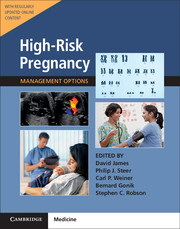Book contents
- High-Risk Pregnancy: Management Options
- High-Risk Pregnancy: Management Options
- Copyright page
- Contents
- Contributors
- Section 1 Prepregnancy Problems
- Section 2 Early Prenatal Problems
- Section 3 Late Prenatal – Fetal Problems
- Section 4 Problems Associated with Infection
- Chapter 24 Hepatitis Virus Infections in Pregnancy (Content last reviewed: 23rd July 2019)
- Chapter 25 Human Immunodeficiency Virus in Pregnancy (Content last reviewed: 23rd July 2019)
- Chapter 26 Rubella, Measles, Mumps, Varicella, and Parvovirus in Pregnancy (Content last reviewed: 11th November 2020)
- Chapter 27 Cytomegalovirus, Herpes Simplex Virus, Adenovirus, Coxsackievirus, and Human Papillomavirus in Pregnancy (Content last reviewed: 11th November 2020)
- Chapter 28 Parasitic Infections in Pregnancy (Content last reviewed: 15th June 2018)
- Chapter 29 Other Infectious Conditions in Pregnancy (Content last reviewed: 11th November 2020)
- Section 5 Late Pregnancy – Maternal Problems
- Section 6 Late Prenatal – Obstetric Problems
- Section 7 Postnatal Problems
- Section 8 Normal Values
- Index
- References
Section 7 - Postnatal Problems
Published online by Cambridge University Press: 15 November 2017
- High-Risk Pregnancy: Management Options
- High-Risk Pregnancy: Management Options
- Copyright page
- Contents
- Contributors
- Section 1 Prepregnancy Problems
- Section 2 Early Prenatal Problems
- Section 3 Late Prenatal – Fetal Problems
- Section 4 Problems Associated with Infection
- Chapter 24 Hepatitis Virus Infections in Pregnancy (Content last reviewed: 23rd July 2019)
- Chapter 25 Human Immunodeficiency Virus in Pregnancy (Content last reviewed: 23rd July 2019)
- Chapter 26 Rubella, Measles, Mumps, Varicella, and Parvovirus in Pregnancy (Content last reviewed: 11th November 2020)
- Chapter 27 Cytomegalovirus, Herpes Simplex Virus, Adenovirus, Coxsackievirus, and Human Papillomavirus in Pregnancy (Content last reviewed: 11th November 2020)
- Chapter 28 Parasitic Infections in Pregnancy (Content last reviewed: 15th June 2018)
- Chapter 29 Other Infectious Conditions in Pregnancy (Content last reviewed: 11th November 2020)
- Section 5 Late Pregnancy – Maternal Problems
- Section 6 Late Prenatal – Obstetric Problems
- Section 7 Postnatal Problems
- Section 8 Normal Values
- Index
- References
Summary
Postpartum hemorrhage (PPH) is the leading direct cause of maternal death in both industrialized and nonindustrialized nations, second only to preexisting conditions and indirect causes of maternal death.
- Type
- Chapter
- Information
- High-Risk PregnancyManagement Options, pp. 1927 - 2086Publisher: Cambridge University PressFirst published in: 2017



